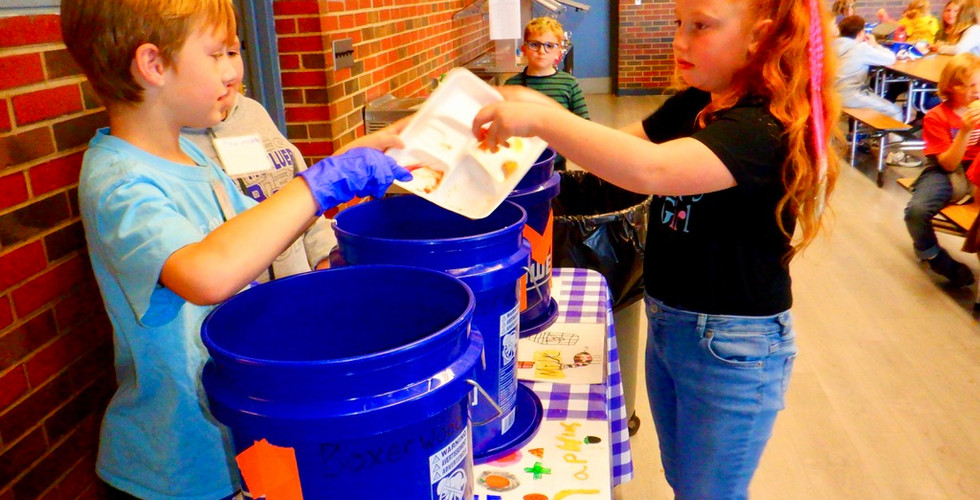In a season of celebrations, local schools this month are also marking an achievement of a different order: the reduction in thousands of pounds of school lunch waste entering the Rockbridge County landfill. As part of a multi-organizational initiative led by Boxerwood, half of the area’s twelve public schools are now actively involved in a new, student-run composting program called Waste Busters.
This year, the program has enabled schools to divert more than 6,500 pounds of food waste from the landfill, most of it in the last five months. “The program is really taking off,” explained Boxerwood education director Elise Sheffield, who recently briefed the Rockbridge County School Board on the success of the endeavor, alongside student leaders and staff representing all four of its participating elementary schools.
The program is a textbook example of collaboration, she said. Initially a start-up grant from the World Wildlife Fund (WWF) enabled Boxerwood to pilot the program with Natural Bridge Elementary in 2022, then expand to Enderly Heights and Parry McCluer Middle School. “Working with these schools enabled us to figure out the logistics,” explained Elise, who oversees the program along with Boxerwood sustainability educator Ginny Jonson. The pilot’s success in turn led WWF to recommend the project to researchers at Johns Hopkins University who themselves are engaged in a national study on US food systems and waste. The university’s research is part of a multi-year project funded by the National Science Foundation (NSF).
As part of their NSF work, the researchers are studying how different cafeteria-based interventions might help reduce student food waste. The researchers invited four school systems across the country to participate in the study, including one rural division: Rockbridge County Public Schools. “It’s a two-year study,” explained Elise, “and it complements our Waste Buster goals nicely.” There are many good reasons to get students involved in composting, she explained, “and if we’re composting anyway, why not see if that action also changes behavior: will the kids eat more of their lunches when they see how much gets thrown out? That’s what the NSF folks are investigating. We hope that’s the case, but we’re already very happy about the other Waste Buster impacts: reduction in food waste to the landfill, better soil for school gardens, and especially increased opportunities for student environmental stewardship and leadership!”
The school board presentation on May 14 highlighted those benefits, as further explained by students and staff from the four composting RCPS schools. Acknowledging that the switch to composting requires new habits and practices, Elise highlighted the front-line leadership of NBES custodian Carson Richards in helping develop the project as well as administrative support from NBES former principal Rick Bain and current principal Melanie Hickman.
Elise also explained how Boxerwood designed the program in respect to each school’s unique limits and opportunities. Representing Mountain View, student government president, Kharlea Mears, explained to the Board how members of her leadership group are the ones who collect, weigh, and compost the lunchtime waste, with support from MVES guidance counselor Kristin Bailey and principal Melanie Camden. Composting at Fairfield in contrast, occurs across three distinct lunchtimes, with peers at each grade level in service rotations designed by their teachers, with support from principal Lauren Fauber.
At the much larger Central ES, teachers, custodians, and students work closely together to ensure that school’s system stays efficient and effective. Under the guidance of principal Robin Parker, the program started as a 4th grade initiative and now as facilitated by teacher Susan Mahood also involves both 2nd and 5th grade lunches as well. Addressing the board, Mahood explained that at Central, students volunteer for the roles and once trained they work in the fast-paced environment as a team, even setting up the system and switching roles if lunchroom adults are otherwise occupied. Fourth grader Jaycee Strong, for example, told the board she took special delight in transporting the stacked trays back to the dishroom.
In addition to expressing gratitude to RCPS administrators and Food Service personnel, Elise also recognized the County of Rockbridge for its role in funding Waste Buster activities. “This program works well because we all put in something,” she said, noting the schools provide the participants, Boxerwood the technical and programmatic expertise, and the County of Rockbridge the underwriting as part of its recycling and solid waste management endeavors. “This is a model that works,” she said, “and we’re so pleased by its impact.”
The Waste Busters program brings not only educational and environmental benefits, she said, but economic ones as well. According to Elise, keeping 6,500 pounds of food scraps from rotting in the landfill prevents the release of methane, a greenhouse gas many times more powerful in the short term than carbon. “Basically, it’s like preventing atmospheric emissions from 19 tons of carbon,” she said. “Once we verify the calculations with a community review team, we’ll post the $2,280 value of that offsetting on Boxerwood’s carbon offset marketplace, COREworks.” Consumers can secure a COREworks offset to balance the carbon generated from some of their own activities like flying. Unlike some larger marketplaces, each COREworks offset represents additional local benefits, such as the educational elements in Waste Busters. At $120/ton, “COREworks offers a premium product,” said Elise, “but a healthier future is worth it!” 100% of proceeds from the COREworks marketplace help launch additional carbon reduction projects in the Rockbridge area such as community tree-planting, thus creating even more local benefits.
For more information about COREworks, visit coreworksva.org, contact Elise at elise@boxerwood.org, or contact Ginny Johnson at ginny@boxerwood.org








